Have you ever watched a nail-biting tennis match between top players and wondered how to play tennis? Tennis is a game that has captivated millions around the world for decades. It offers an incredible blend of physical, mental, and social benefits, making it an ideal pastime for people of all ages and skill levels.
This comprehensive guide will walk you through the essentials of tennis, from equipment to technique, scoring, and etiquette. So, grab your tennis racket and prepare to embark on an exciting journey into the world of tennis!
Discover your ideal racket effortlessly with our Racket Finder!
In this blog post, you will discover the allure of tennis and learn about the essential equipment needed to play the game. You will also explore the layout of a tennis court, learn the techniques to master tennis strokes, and understand the rules and strategies that govern this fascinating sport.
Moreover, this guide will provide you with useful tips for practicing tennis solo, playing doubles, finding tennis partners and clubs, and learning from professional players. By the end of this post, you will be well-equipped with the knowledge and enthusiasm to step onto the tennis court and enjoy this amazing sport, knowing how to play tennis.
Key Takeaways
- Tennis offers physical, mental and social benefits. Essential equipment includes a racket, balls, clothing & shoes.
- Mastering strokes such as forehand/backhand/volley is key for success in tennis matches.
- Tennis etiquette & sportsmanship are important to ensure an enjoyable experience for all players.
The Allure of Tennis

Tennis is a physically demanding sport that can be played in singles or doubles matches, offering a fantastic workout for both body and mind. Playing tennis can improve hand-eye coordination, balance, and agility. However, the benefits of this sport go beyond physical fitness. Tennis has been noted to enhance problem-solving abilities and critical thinking, making a tennis player mentally strong.
The social aspect of tennis is also significant. Tennis trains social skills and teamwork abilities, which can be further developed by joining tennis clubs and participating in group activities. From friendly matches at the local park to competing at the prestigious four grand slams, tennis offers an exciting and rewarding experience for players of all skill levels. So, whether you are a beginner looking to pick up a racket for the first time or an experienced player seeking to improve your game, tennis has something for everyone.
Explore top-rated tennis rackets tailored to your playing level!
Essential Tennis Equipment
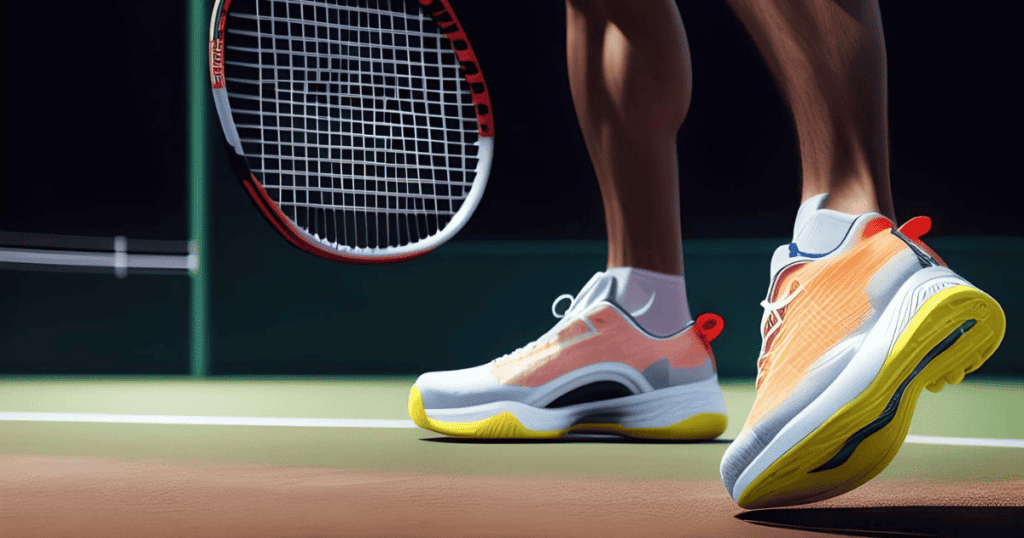
Starting your tennis journey requires some fundamental equipment:
- A tennis racket
- Tennis ball
- Court-specific shoes
- Appropriate clothing
When selecting a racket, beginners should consider a racket with a broad head to diminish the likelihood of missing the ball while playing on tennis courts. Tennis rackets come in various materials and price ranges, starting at approximately $50 and can exceed over $400.
Replacing deflated balls is necessary for maintaining optimal performance during practice and matches.
As for clothing, comfortable and movement-friendly attire is recommended, preferably with pockets for holding balls during serves. Lastly, invest in a pair of appropriate tennis shoes, as they provide protection and support for your feet, especially when playing outdoors on a concrete court.
Tennis Court Basics

For beginners to play effectively and appreciate the game, familiarizing themselves with the layout of a tennis court is imperative. A tennis court is divided into different sections, including singles and doubles sidelines, and service boxes.
This section explores each of these areas in depth, shedding light on their significance in singles and doubles matches.
Singles’ Sideline
In singles tennis:
- The singles’ sideline outlines the boundary for singles play.
- The inner alley lines are utilized to determine the playing area.
- Any ball that lands within these boundaries is considered to be in play.
Awareness of the singles’ sideline is vital in singles play as it assists with correct positioning on the court and helps strategize shots within the boundaries.
Doubles’ Sideline
The doubles sideline is the outermost line that delineates the boundaries for doubles play in terms of width. In doubles tennis, the playing area is expanded by 1.37 meters beyond the singles court sideline. This larger court size allows players to leverage various angles and strategies that may not be feasible in singles play.
Recognition of the doubles sideline and adjusting your positioning and shot choices accordingly are vital for success in playing doubles, especially in doubles tennis.
Service Box
The service box is the designated area for serving in tennis, situated in the corner opposite the server’s position. When serving, the ball must land within the service box to be considered a valid serve. If the serve lands outside the service box or hits the net, it is deemed a fault, and the server is granted another attempt.
A double fault occurs when a player’s second serve is not successful. This means that the receiving player wins the point.. Gaining an advantage in tennis matches requires mastering the art of serving within the service box boundaries.
Mastering Tennis Strokes

To become a proficient player, it’s necessary to develop your tennis strokes. Tennis strokes include the forehand, backhand, drop shot, overhead shot, slice, smash, and lob.
This section concentrates on the crucial strokes of tennis: forehand, backhand, and volley. We will provide step-by-step guidance on mastering these critical strokes to help you improve your technique and consistency on the court.
Forehand Technique
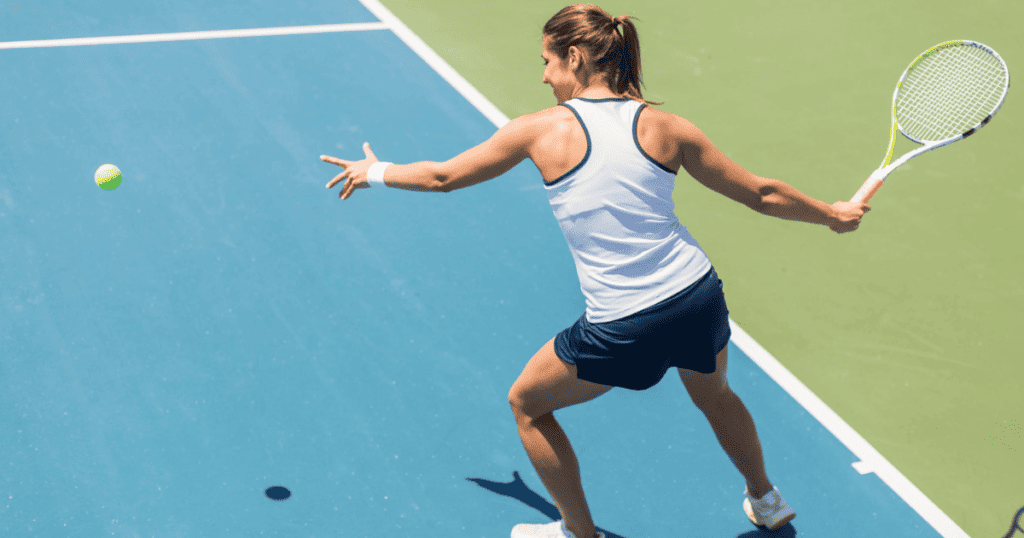
The forehand stroke is a fundamental shot in tennis, executed by swinging the racket across one’s body in the direction of where the player wishes to place the shot. To master the forehand technique, start by adopting the Eastern grip, which is frequently utilized by beginners due to its comfort. The grip should be with one’s palm slightly behind the handle and one’s wrist at the left butt end of the handle.
When swinging the racket, it is imperative to turn one’s hips and upper body as a single unit and follow through over one’s shoulder. The follow-through is of great importance as it facilitates the production of power and accuracy in the shot, as well as guaranteeing that the ball is directed to the intended destination.
With practice and repetition, your forehand stroke will become more powerful and precise, making it an essential weapon in your tennis arsenal.
Backhand Mastery
The backhand stroke is another critical shot in tennis, executed by swinging the racket away from one’s body in the direction of the desired trajectory. Backhands can be performed with one or two hands, depending on personal preference and comfort. The backhand is generally perceived as more challenging to perfect than the forehand, as the dominant hand “pulls” into the shot, often resulting in a lack of power and consistency compared to the forehand.
To master the backhand stroke, focus on developing the correct technique while generating sufficient force and managing the trajectory of the shot. Utilize footwork and body rotation to generate power and ensure that you strike the ball at the optimal contact point. With consistent practice, your backhand stroke will become a reliable and effective tool in your tennis game.
Volley Precision
The volley is a vital component of net play in tennis, executed by swiftly striking the ball over the net before it bounces. The volley requires quick reflexes, precise timing, and proper technique. To achieve precision and control in your volleys, start by adopting the continental grip, which is the correct grip for a volley.
When executing a volley, follow these steps:
- Maintain a ready position with your feet shoulder-width apart and knees slightly bent.
- Rotate your shoulders slightly to the right (or left) until the racket is in line with your right (or left) shoulder.
- Perform a swift “punching” motion towards the ball.
- The follow-through for a volley is shorter than that for the regular forehand groundstroke; the racket should not traverse the anterior of one’s body.
By honing your volley technique through practice, you will develop the precision and control necessary for successful net play in tennis.
Serving with Confidence

Any tennis player’s arsenal is incomplete without a powerful and accurate serve. Each point in a match begins with a serve, so mastering it is key to gaining an upper hand over your opponent. To serve with confidence, begin by understanding the proper grip, stance, ball toss, and follow-through for a successful serve.
The grip for serving is typically the continental grip, which allows for a combination of power, spin, and control. The stance should be balanced and comfortable, with your feet positioned shoulder-width apart and your weight on the back foot. As you toss the ball, use a smooth and consistent motion, aiming for a ball height that allows you to fully extend your arm at the point of contact.
Lastly, ensure a smooth and fluid follow-through, transfer your weight from the back foot to the front foot, and finish with your racket on the opposite side of your body. With practice and consistency, you will be able to serve with confidence and accuracy, setting the stage for successful points in your tennis matches.
Tennis Scoring Demystified
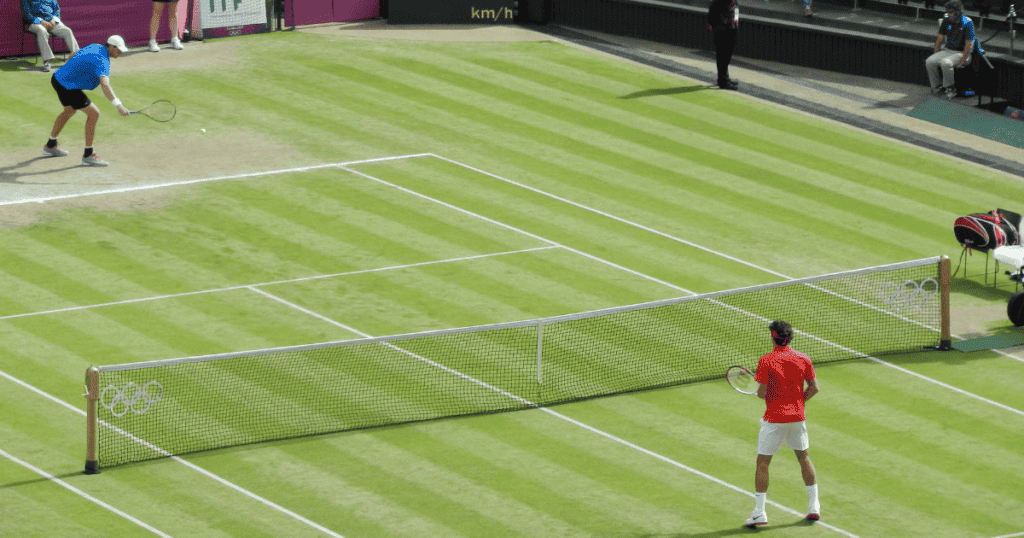
For beginners to keep track of their progress during a match and remain engaged in the game, comprehension of the tennis scoring system is pivotal. Tennis scoring can seem complex at first, but with a clear explanation, it becomes much more straightforward.
Points accumulate to constitute a game, games accumulate to constitute a set, and winning sets culminates in winning the match. The sequence of scores in a tennis game is:
- 0
- 15
- 30
- 40
- Game
Four points are needed to win a game.
In most matches, a player must win six games to win a set, and two sets to win the match. If both players reach six games each in a set, a tiebreaker is played to determine the winner of the set. During a tiebreaker, players must win at least seven points, and if the score reaches 6-6, they must win two consecutive points to secure the set.
By understanding the tennis scoring system, you will be better equipped to follow the progress of your matches and maintain your focus on the game at hand.
The Rules of Engagement

A basic understanding of the game’s tennis rules is necessary to play tennis correctly and fairly. The goal of tennis is to:
- Hit a ball back and forth over a net
- Earn a point when one player is able to outscore their competitor
- Earn a point when the opponent fails to hit the ball, strikes the ball outside of the boundary, or strikes the ball into the net.
In addition to these basic rules, there are specific regulations for serving, playing the ball, and winning points. When serving, the ball must land within the service box on the opposite side of the court. If the serve lands outside the service box or hits the net, it is deemed a fault, and the server is granted another attempt. A double fault occurs when a player’s second serve is not successful. This means that the receiving player wins the point..
By adhering to these basic rules, you will ensure that you play the game correctly and fairly, fostering a positive and enjoyable experience for both you and your opponent.
Strategy and Tactics

Formulating a winning tennis game plan involves comprehending and executing effective strategies and tactics. Court positioning, shot selection, and exploiting opponents’ weaknesses are all crucial aspects of a successful tennis strategy. Strategic positioning on the court can reduce your opponent’s reaction time, compel them to execute difficult shots, and open up opportunities for your winning shots.
Shot selection is another key element of tennis strategy, as choosing the right shot for each situation can significantly increase your chances of success. Some tips for shot selection include:
- Playing assertively and capitalizing on your strengths
- Striking the ball to your opponent’s disadvantage
- Mixing up the pace and spin of your shots to keep your opponent guessing and off-balance.
By following these tips, you can improve your shot selection and enhance your overall performance on the tennis court.
By continuously analyzing and adapting your strategy and tactics during a match, you will be better equipped to outsmart your opponent and secure victory on the court.
Practicing Tennis Solo

In addition to practicing tennis with a partner or in a group, there are numerous methods to enhance your skills when practicing solo. One effective solo practice technique is hitting against a wall or backboard.
This can help you enhance your accuracy, consistency, and power while allowing you to practice without a partner. When hitting against a wall or backboard, focus on striking the ball in the same spot on the wall each time, and adjust your distance from the wall to simulate different types of shots.
Another useful solo practice method is using ball machines or practice aids. These devices can help you improve your tennis skills in several ways:
- Improve accuracy: By adjusting the speed and spin of the ball, you can practice hitting the ball to specific targets on the court.
- Enhance consistency: By repeatedly hitting balls from the same spot, you can work on developing a consistent stroke.
- Increase power: By practicing against a ball machine or using a practice aid, you can focus on generating more power in your shots.
When using a ball machine or practice aid, adjust the settings to match your skill level, and concentrate on consistently striking the ball in the same spot.
With dedicated solo practice and a focus on technique, you can continually refine your tennis skills and become a more confident and capable player.
Doubles Dynamics
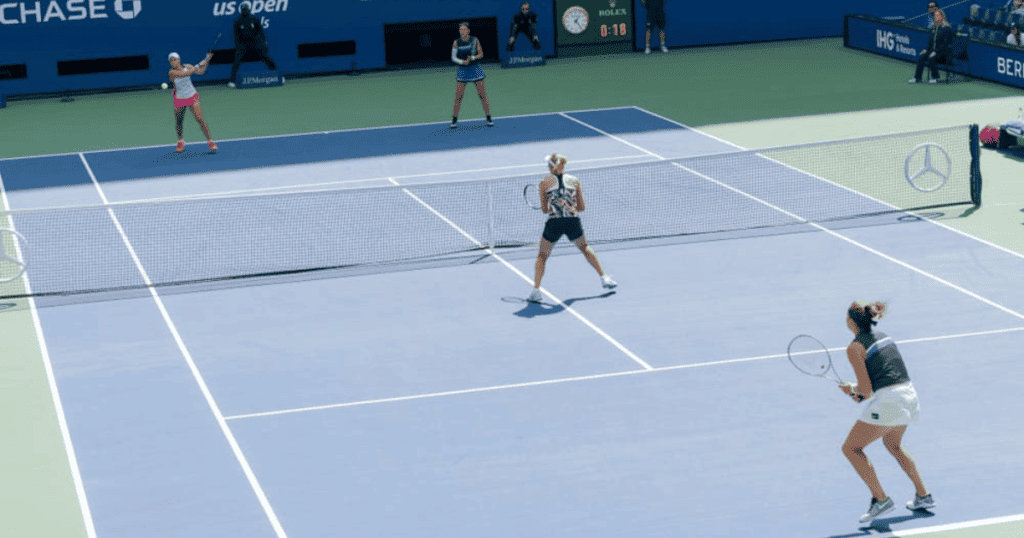
Doubles tennis, a unique and exciting game variation, demands effective teamwork, communication, and specific strategies for success. In a doubles tennis match, two teams of two players each compete against each other, with each team member standing on opposite sides of the court. The court is divided into two halves, and the playing area is expanded by 1.37 meters beyond the singles court sideline, providing more angles and opportunities for creative play.
Effective communication between teammates is essential in doubles tennis, as it allows for efficient decision-making and coordination on the court. This includes discussing tactics, calling out shots, and providing encouragement and support throughout the match.
In addition to communication, doubles dynamics involve a combination of serves, net play, and teamwork to outmaneuver the opposing team. By mastering the unique dynamics of doubles tennis, you and your partner can enjoy a thrilling and competitive experience on the court.
Finding Tennis Partners and Clubs
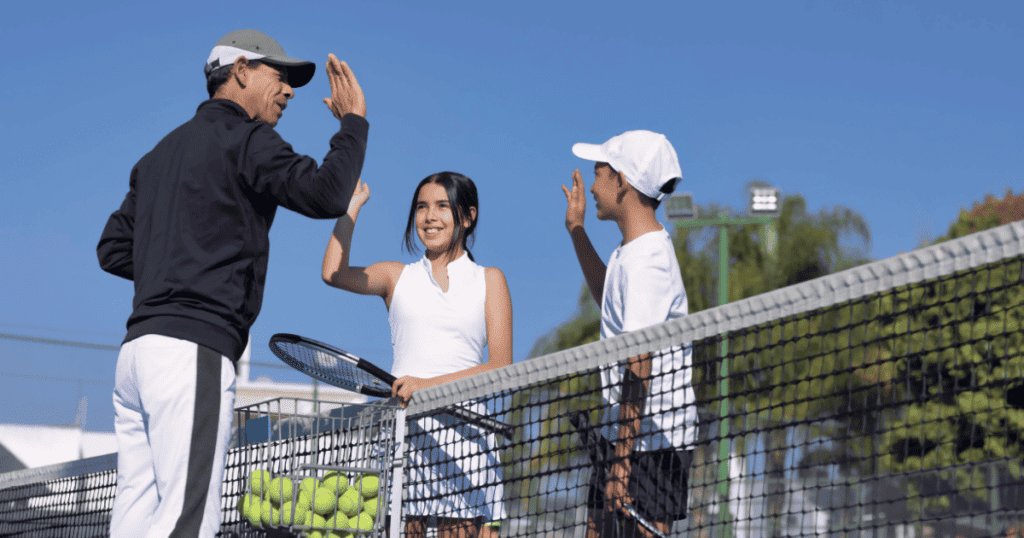
Establishing connections with other tennis players and seeking competitive play opportunities are important for enjoyment and improvement in tennis. To find tennis partners, you can:
- Inquire amongst friends or acquaintances
- Join a local tennis club or community center
- Utilize online platforms and apps designed for finding tennis partners, such as LeisureClique or Let’s Play Tennis
- Investigate social media groups or forums dedicated to tennis in your area
- Attend tennis events or tournaments
- Engage a professional hitting partner or coach
To locate a tennis club in your vicinity, conduct an online search, inquire with your local parks and recreation department, or consult with individuals who partake in tennis.
Joining a tennis club can provide you with access to tennis courts, coaching, and organized events, as well as the opportunity to meet other tennis enthusiasts and form lasting friendships. By connecting with other players and participating in the tennis community, you will enhance your enjoyment of the sport and create a supportive network for your tennis journey.
Learning from the Pros

For beginners aiming to elevate their game, learning from professional tennis players can offer an invaluable dose of inspiration and knowledge. Watching professional matches, attending clinics and instructional videos, and studying the techniques and strategies employed by the pros can provide you with new insights to apply to your own game. Observing the mental fortitude and concentration of professional players can also help you understand the importance of the mental aspect of the game, and inspire you to develop your own mental strength.
When watching professional matches, focus on the tactics and techniques used by the players, and consider how you can incorporate these elements into your own game. Attending clinics and instructional videos can provide you with an understanding of the fundamentals of the game, as well as advanced techniques and strategies. By learning from the pros and applying their insights to your own game, you can significantly improve your skills and confidence on the tennis court.
Tennis Etiquette and Sportsmanship

In tennis, etiquette and sportsmanship are core values. Players should maintain a respectful and friendly attitude during matches to enhance the experience for everyone. Honest line calls show respect for the opponent and promote fair play. It’s also vital to keep score to determine the winner accurately.
Maintaining a respectful and friendly demeanor in matches fosters a positive court atmosphere and highlights good sportsmanship. This means offering a handshake after the match, praising your opponent for a good shot, and avoiding negative behavior.
By following tennis etiquette and showing sportsmanship, you elevate the tennis environment and embrace the sport’s true spirit.
Summary
In conclusion, tennis is an exciting and rewarding sport that offers physical, mental, and social benefits for players of all ages and skill levels. By understanding the essentials of tennis, such as equipment, court layout, strokes, serving, scoring, rules, and etiquette, you can enjoy the game and continually improve your skills.
Connecting with other players, learning from the pros, and embracing the unique dynamics of doubles tennis will further enhance your enjoyment of the sport. So, put on your tennis shoes, grab your racket, and step onto the court to experience the thrill and camaraderie of the wonderful world of tennis!
Frequently Asked Questions
How do you play basic tennis rules?
Playing basic tennis rules involves hitting the ball over the net and into the margins of the court, without letting it bounce twice. The player must wait for the ball to pass the net and cannot step over it, and a point is won when the opponent cannot return the ball within the court. Scoring in tennis is based on a point system. A player must win four points to win a game, and six games to win a set. The first player to win two sets wins the match. The winner
How can I learn to play tennis by myself?
To learn tennis by yourself, start with the basics and get proper equipment, then hit against a wall or backboard, practice with a ball machine, have a friend to practice with, get feedback from experienced players, and watch professional matches. This will help you face the challenges of learning tennis on your own.
How do you score tennis?
In tennis, scoring is based on the points system; love (0 points), 15 (1 point), 30 (2 points), 40 (3 points). If the game is tied at 40-40 (deuce), then it continues until one player has a two-point lead. To win a game, players must score four points and to win a match, they must win two or three sets of six games each.
How many strokes are there in tennis?
There are six strokes in tennis, namely the serve, forehand groundstroke, backhand groundstroke, forehand volley, backhand volley, and the overhead smash. These are fundamental movements performed to hit a tennis ball.
How do I choose the right tennis racket for a beginner?
For beginner tennis players, it is recommended to choose a racket with a broad head that will help make accurate shots on the court. This should give you the best chances for success as you get used to the game.



